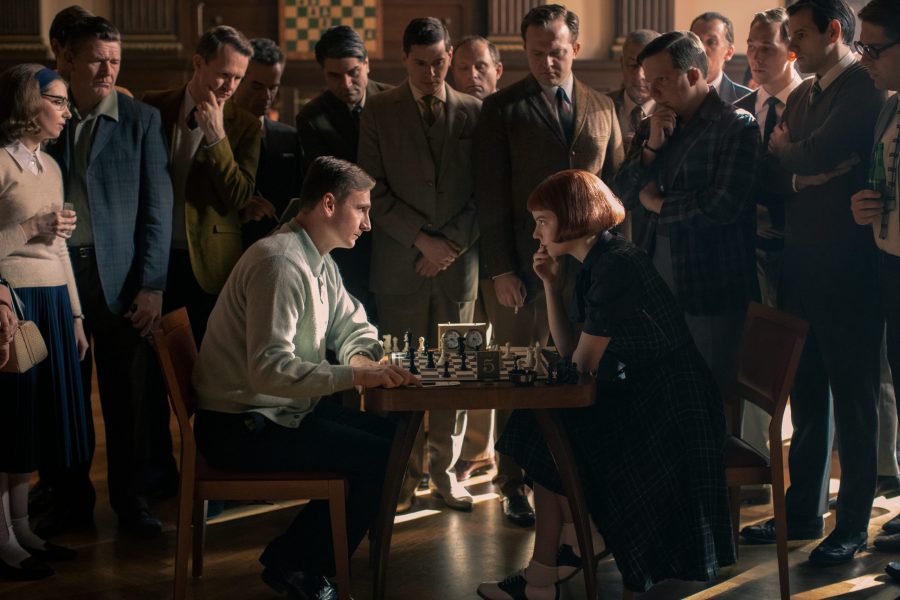You don’t need to know the game to enjoy this show about competitive chess.
Oct. 23, 2020 marked the release of yet another Netflix original limited series, titled “The Queen’s Gambit.” Starring favored actors Anya Taylor-Joy and Thomas Brodie-Sangster, “The Queen’s Gambit” follows a young orphan through her journey of discovering the world of competitive chess as a woman. With its use of visual effects and 1960s production design, “The Queen’s Gambit” has risen to the top of many watchlists.
Although the show does not explicitly explain the rules of chess to the audience, the producers do display the game in adventurous ways. To project Harmon’s visualizations of chess plays, VFX projections of a chess set were cast to the top of different shots. These visual representations provide more information to the audience, as it allows Harmom’s daydreams to break out of their phantom genius and be displayed on screen. The use of VFX also symbolizes the manifestation of Harmon’s drug addiction in her consciousness and how the first chess board she ever used was a comfort to her. The board used in the VFX was modeled after the chess board she played on with her first teacher, the same board that she first won on and found her love for chess with. “[Harmon] learned in the basement and that’s where she would go back to if she had a conflicting moment,” VFX supervisor Arissa Blasingame said in Variety’s article covering the show. It is clear that when faced with new territories, such as chess tournaments across state lines or across oceans, she is still able to visualize chess plays on a board she is familiar with.
Upon its release, “The Queen’s Gambit” made waves in production and costume design. With the backdrop of the plot being the sixties, it was obvious the show’s aesthetic required poodle skirts, light makeup with red lips, saddle oxford shoes, pops of neon colors, etc. The Brooklyn Museum released an exhibition highlighting the artistry behind the costume design of the show; Gabriele Binder, the costume designer for “The Queen’s Gambit,” revealed at the exhibition that Harmon’s costumes are “meant to reflect the growing sophistication and self-assurance of [Harmon].” The audience watches as Harmon grows more comfortable with her identity, as marvelously displayed when Harmon walks through the halls of her highschool and tells her bully to “f[***] off.” The costumes she wears changes from poodle skirts to turtleneck dresses and heels, mimicking her growth into sophistication. With production quality of this caliber, it is hard not to fall in love with the limited series.
Unfortunately, a major drawback for the show is the lack of necessity for the narrative. Although there is not much media coverage of chess, fictional or nonfictional, a story about a white woman discovering the world of the male-dominated sport of competitive chess is lackluster. There are many stories and television shows that are about white women, including “The Crown,” “Unbelievable,” “New Girl,” “The Unbreakable Kimmy Schmidt,” and “The Chilling Adventures of Sabrina.” Even “Orange is the New Black” is a show with many star actors of women of color but a white woman lead actor. It’s apparent that narratives focusing on white women are slowly becoming overused and that viewers are not as interested in watching them. The film industry cannot appease the lack of femme faces in the film industry without including Black, Indigenous, and People of Color voices; however, it appears that is what they are trying to do.
The story of “The Queen’s Gambit” is based on the novel “The Queen’s Gambit” by Walter Tevis, and although the narrative is fictional, many characters and events are inspired by Tevis’ life. “The Queen’s Gambit” could have easily cast any woman to be Beth but ultimately chose Anya Taylor-Joy, a white-passing Argentinian actor. There was a massive missed opportunity to arm a better main character with Tevis’ narrative than a white woman. One of these characters is Jolene. Acted by Moses Ingram, Jolene is a young black woman living in the foster care system in the 1960s. She isn’t given a last name and is barely mentioned in the plot except for aiding young Harmon in the foster home and helping older Harmon through her drug and alcohol addiction.
There were only glimpses of Jolene’s life on screen. She quips about how the foster home treats her poorly and confesses to Harmon about her discovery of racism and new hardships outside the foster home. Although only briefly mentioned, these moments were so rich in uncharted screenplay territory that we as viewers wish for more expansion on Jolene and her whereabouts within the show. The use of a BIPOC narrative that is only mentioned in moments of lag or necessity acts as a slap in the face to BIPOC audience members. Her narrative should have either been the main exploration of the plot or omitted from the show altogether. It is time the media industry recognizes narratives casting just white actors and shows picking up white narratives are growing repetitive and unexciting. It’s time BIPOC actors and narratives are recognized for their talent.
Grade: B+
Created By: Scott Frank, Allan Scott
Starring: Anya Taylor-Joy, Thomas Brodie-Sangster, Marielle Heller
Release Date: October 23, 2020
Rated: Rated TV-MA
Image courtesy of About Netflix.








